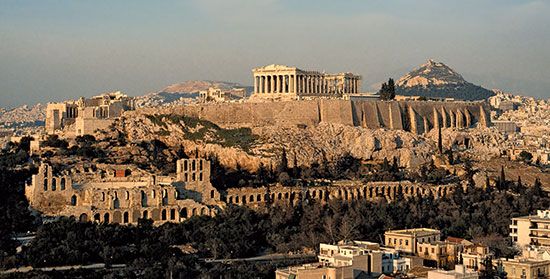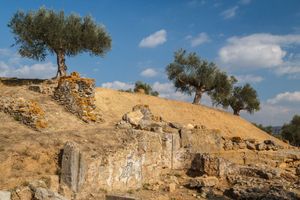city-state
city-state, a political system consisting of an independent city having sovereignty over contiguous territory and serving as a centre and leader of political, economic, and cultural life. The term originated in England in the late 19th century and has been applied especially to the cities of ancient Greece, Phoenicia, and Italy and to the cities of medieval Italy.
The name was initially given to the political form that crystallized during the classical period of Greek civilization. The city-state’s ancient Greek name, polis, was derived from the citadel (acropolis), which marked its administrative centre; and the territory of the polis was usually fairly limited. City-states differed from tribal or national systems in size, exclusiveness, patriotism, and passion for independence. The origin of city-states is disputed. It is probable that earlier tribal systems broke up during a period of economic decline and the splintered groups established themselves between 1000 and 800 bce as independent nuclei of city-states that covered peninsular Greece, the Aegean islands, and western Asia Minor. As they grew in population and commercial activity, they sent out bands of emigrants who created similar city-states on the coasts of the Mediterranean Sea and the Black Sea, mainly between 750 and 550 bce.
The thousands of city-states that sprang into existence during these centuries were remarkable for their diversity. Every variety of political experiment from monarchy to communism was practiced, and the fundamental principles of political life were formulated by their philosophers. The vigour and intensity of the citizens’ experience were such that they made unparalleled advances in all fields of human activity, except industry and technology, and laid the basis of Greco-Roman civilization. The particularism of city-states was their glory and their weakness. Incapable of forming any permanent union or federation, they fell victim to the Macedonians, the Carthaginians, and the Roman Empire, under which they lived on as dependent privileged communities (municipia). Rome, which began its republican history as a city-state, pursued policies of foreign expansion and government centralization that led to the annihilation of the city-state as a political form in the ancient world.

The revival of city-states was noticeable by the 11th century, when several Italian towns had reached considerable prosperity. They were mostly in Byzantine territory or had maintained contact with Constantinople (Istanbul) and could thus take full advantage of the revival of eastern trade.
Foremost among them were Venice and Amalfi, the latter reaching the height of its commercial power about the middle of the century; others included Bari, Otranto, and Salerno. Amalfi, for a short time a serious rival of Venice, declined after having submitted to the Normans in 1073. Then Venice received, with the privilege of 1082, exemption from all customs duties within the Byzantine Empire. In the 11th century Pisa, the natural port of Tuscany, began to rise amid struggles with the Arabs, whom it defeated repeatedly; and Genoa, which was to be its rival for centuries, was following suit. Among the inland towns—as yet less conspicuous—Pavia, which had owed much of its early prosperity to its role as capital of the Lombard kingdom, was rapidly outdistanced by Milan; Lucca, on the Via Francigena from Lombardy to Rome and for a long time the residence of the margraves of Tuscany, was the most important Tuscan inland town.
The importance of fortified centres during the Hungarian and Arab incursions contributed to the development of towns. Town walls were rebuilt or repaired, providing security both to citizens and to people from the country; and the latter found further places of refuge in the many fortified castelli with which the countryside began to be covered.
The Norman conquest of southern Italy put an end to the progress of municipal autonomy in that region. Whether it took the form of a conflict with the established authorities or of peaceful transition, the ultimate result of the communal movement in the north was full self-government. Originally the communes were, as a rule, associations of the leading sections of the town population; but they soon became identical with the new city-state. Their first opponents were often, but by no means always, the bishops; in Tuscany, where margravial authority was strong, the Holy Roman emperor Henry IV encouraged rebellion against his rival Matilda by granting extensive privileges to Pisa and to Lucca in 1081; and Matilda’s death made it possible for Florence to achieve independence.
The first organs of the city-state were the general assembly of all its members (parlamento, concio, arengo) and the magistracy of the consuls. At an early date a council began to replace the unwieldy assembly for ordinary political and legislative business; and, with the growing complexity of the constitution, further councils emerged, conditions varying considerably from town to town. During the 12th century, the consular office was usually monopolized by the class that had taken the initiative in the establishment of the commune. This class was usually composed of small feudal or nonfeudal landowners and the wealthier merchants. In Pisa and Genoa the commercial element was predominant, while in parts of Piedmont the commune derived from the associations of the local nobility. Thus the early city-state was predominantly aristocratic. The fortified towers of the leading families, resembling the feudal castles of the countryside, were characteristic of these conditions. In Italy there had in fact never been the same separation between town and countryside as there had been, for instance, in northern France and in Germany; feudal society had penetrated into the towns, while nonnoble citizens were often landowners outside their walls. This link between town and country was to become stronger and more complex in the course of communal history.
From the beginning the conquest of the countryside (contado) became one of the main objectives of city-state policy. The small fortified townships (castelli) and the lesser rural places were now absorbed by the city-states. The divisions and subdivisions of feudal property, partly the result of the Lombard law of inheritance, weakened many feudal houses and thus facilitated the conquest, while the bishops could not prevent the extension of communal control to their lands. The members of the rural nobility were subjected one by one and often forced to become citizens; others did so voluntarily. Only a small number of the more powerful families, such as the house of Este, the Malaspina, the Guidi, and the Aldobrandeschi, succeeded in maintaining their independence—and that not without frequent losses and concessions.

















